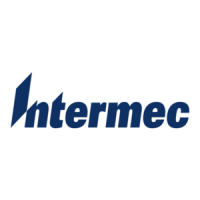Co de 39
Nugget
Operating the Terminal in a Network
4-21
4
Controller IP Address An IP address is a unique network level address you assign to
each device in a TCP/IP network. The Controller IP Address identifies the IP address
assigned to the DCS 300 in a UDP Plus network.
Host IP Address An IP address is a unique network level address you assign to each
device in a TCP/IP direct connect network. The Host IP Address identifies the IP address
assigned to the host.
Terminal IP Address An IP address is a unique network level address you assign to
each device in a TCP/IP network. The Terminal IP Address identifies the IP address
assigned to the T2425. The IP address you set on the terminal must match the address
that is set for the terminal on the DCS 300 or host.
Network Port Defines the network port that the TCP/IP or UDP Plus network protocol
uses for communications in your RF network. In a UDP Plus network, the network port
you set on the T2425 must match the network port that is set on the DCS 300. In a
TCP/IP network, set the network port to the appropriate port for the application you are
using on the T2425. The default network port of 23 enables VT/ANSI Telnet
communications.
RF Domain The domain defines a logical partition or subnetwork of the network. To
establish communications, you must assign the same domain number to every RF device
in a wireless network. The domain number you set on the terminal must match the
domain that is set on each access point the terminal may communicate with. You can
continue to collect data with the terminal as you roam between access points as long as
all the devices have the same domain number.
RF Security Identification (ID) This parameter defines the password you can set for
secured transmission and receipt of data between devices in the wireless network. If the
security ID is set on the access point, you must also set the security ID on each T2425
that may communicate with the access point. To communicate, each access point and
terminal must have matching security IDs.
Note:
The Network Activate command must be configured to 2.4 GHz RF network
before you can save any changes to the RF security ID parameter.
Default Router Provides a software and hardware connection between two or more
networks that permits traffic to be routed from one network to another on the basis of the
intended destinations of that traffic. When the DCS 300 (UDP Plus) or host (TCP/IP) is
on a different subnetwork than the T2425, you need to set the default router IP address.
The terminal uses the router address to send packets across the network to the DCS 300
or host. The default router must have an IP address on the same subnetwork as the
terminal. The default of 0.0.0.0 means there is no default router.
Subnet Mask The subnet mask is an internal TCP/IP protocol stack variable that is
used in IP protocol to identify the subnetwork for an IP address. The IP protocol
performs a bit-wise AND on the IP address and the subnet mask. Each address segment
represents one byte, where 255 converts to FF hex. This computation is used to find out
if the DCS 300 (UDP Plus) or host (TCP/IP) and terminal are on different subnetworks.

